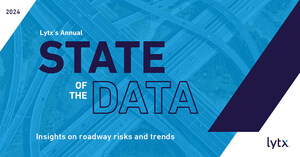With Roads Busier Than Ever, Lytx Publishes 2023 "State of the Data" Report to Help Fleets Improve Driver and Road Safety, Save Costs, and Increase Operational Efficiency
SAN DIEGO, May 23, 2023 /PRNewswire/ -- Lytx® Inc., the global leader in video safety and video telematics, today released its fifth annual "State of the Data" report for trucks and vehicle fleets. Leveraging the Lytx Driver Safety Program and over 36 billion miles of new driving data (over 221 billion miles total) captured through Lytx's DriveCam® Event Recorders, 2022 showed a decrease in overall risky driving even as miles driven increased. Report findings also highlight the significant influence that time of day, day of week, road conditions, and specific road segments played in risky driving behavior and collisions.
Risky driving behaviors can come with immense costs to life and property. In fact, The National Safety Council estimated that comparing pre-pandemic 2019 to 2022, the death rate on American roads increased nearly 22%. However, there is reason for hope based on the annual report from the National Highway Traffic Safety Administration (NHTSA), which estimated that there were 31,785 traffic fatalities in the United States in the first nine months of 2022. While tragic, this was a decrease of 100 compared to the same period in 2021, even as the Federal Highway Administration showed that vehicle miles traveled in the first nine months of 2022 increased by around 39 billion miles.
"Over the last four years, due in large part to COVID-19 and global supply chain disruptions, we have experienced unprecedented changes in driving behaviors," said David Riordan, Lytx's Executive Vice President and General Manager, Enterprise. "Only through data is there objective and actionable understanding. We hope that by sharing the findings in this report, derived from extensive data from the Lytx Vision Platform, we can help fleets celebrate their wins in 2022, as well as provide insights to help them save money, time, and most importantly, lives."
**Highlights from the 2023 "State of the Data" Report**
RISKY DRIVING
Looking at data from 2019-2022, roads continued to be extremely dangerous as traffic returned to pre-pandemic levels last year. According to NHTSA, fatalities showed signs of leveling off in 2022 but remained elevated after two years of dramatic increases. However, at the same time, drivers utilizing Lytx technology and safety programs continued to show long-term improvements in safe driving, resulting in a significant drop in risky driving and collisions per mile traveled in 2022, compared to 2019.
Positive trends in driving behavior: Overall risky driving decreased in 2022
- In 2022, overall risky driving improved by a significant 29% over 2019 (the last "normal year" before COVID-19 related disruptions). As Lytx's technology continues to evolve and deliver new innovations to detect risk, it also provides clients with the highest level of configurability, which helps clients drive down risks through a combination of coaching workflows and automated driver self-improvement with MV+AI in-cab alerting.
- The Lytx Risk Score for 2019 was 18.3, while in 2022 it improved to 12.9.
- Collisions per 1,000,000 miles driven also dropped, resulting in a 23.1% decrease from 2019 to 2022.
According to the data and analytics, as traffic returned to pre-pandemic levels on the roads, drivers showed measurably safer and more attentive driving habits, resulting in fewer collisions per miles driven.
Powering the Lytx Risk Score, Lytx captured more than 14 million risky driving incidents within vehicle fleets in 2022. Roadways and behaviors were examined and measured using Lytx's proprietary risk-scoring system, which calculates behavior averages across a variety of industries using driving data from Lytx's global database.
Driving down risk
Drivers showed significant improvement in certain risky driving behaviors, when comparing 2022 to recent years. This progress can be attributed to more fleets employing coaching tools and workflows that allow fleet managers and drivers to work together to continually identify areas of improvement and reward risk reduction.
The following were the five most improved risky driving behaviors from 2021 to 2022
Not scanning roadway |
Down 18% |
Blank stare |
Down 16% |
Driving too fast for conditions, |
Down 11% |
Driver unbelted on a residential road |
Down 10% |
Veering off identifiable roadway |
Down 9% |
While various driving habits improved over the last year, "driving too fast for conditions" was also the number one improved risky driving habit comparing 2022 to 2020, down 52%, and number two down 74%, comparing 2022 to 2019.
Top five riskiest driving cities
- New York, NY
- Philadelphia, PA
- Los Angeles, CA
- Chicago, IL
- Dallas/Fort Worth, TX
While many of 2021's riskiest driving cities remained in the top five, Atlanta improved to number seven, while Dallas/Fort Worth entered the top five. New York remained number one for the second year in a row.
Top five riskiest public roadways
- Michigan (I-94 at Merriman Road, Romulus)
- A complex airport interchange
- New York (George Washington Bridge near Riverside Drive, NY)
- The world's busiest vehicular bridge
- California (Edom Hill Road and Varner Road, Desert Hot Springs)
- A lack of lane markings
- New Jersey (NJ19 and I-80 in Paterson)
- A complex interchange, with highways terminating into city streets
- Connecticut (I-95 near Fulton Terrace, New Haven)
- A curved freeway entering the busy port of New Haven
Airports have emerged as some of the nation's most dangerous driving areas
- 14 out of 30 of the highest-risk sections of public and private roadways were within two miles of airports, in 2022. This number was up 86% from 2021, when eight of the top 30 highest-risk roadways were near airports.
- Top five high-risk airports to drive around:
1. Denver International
2. John Glenn Columbus International
3. Phoenix Sky Harbor
4. John F. Kennedy International
5. Newark Liberty International
"Airports likely stand out as having among the more dangerous roadways due to several factors, including the high number of intersections and transitions, the high percentage of drivers unfamiliar with the routes, the high concentration of cars, and of course, hurried or distracted behaviors such as looking at mobile phones," said Kyle Warlick, Senior Client Intelligence Analyst at Lytx.
IT MATTERS WHEN YOU DRIVE
Time of day impacts the likelihood of a collision
- In 2022, the highest total number of collisions occurred during the daytime hours (6am-4pm), with the most occurring at 11am.
- Alternatively, the highest collisions per vehicle (those on the road at each hour) occurred in the middle of the night (2am-6am), with 2am the most likely time for a collision.
The data showed that while the largest number of collisions occurred when traffic volumes are highest during the day, and per vehicle collisions occurred most often late at night when visibility is darkest and traffic volumes were lower.
Even the day of the week impacts the likelihood of a collision
- In 2022, the highest collisions per vehicle occurred on Tuesdays.
- Saturdays were the safest day of the week, with the lowest collisions per vehicle. Sundays were second lowest.
Findings suggest that high weekday commute traffic very closely correlated to higher numbers of collisions and was further supported by weekend lows.
Most collisions happen in clear weather, often due to animal strikes
- While 13.1% of collisions occurred during rainy weather, 83.9% occurred in clear conditions, with only 2.9% occurring in snowy weather and 0.1% in foggy conditions.
- Animal strikes accounted for 29.7% of the collisions in clear weather and 9.4% in rainy conditions. In contrast, fixed objects accounted for 11.7% of accidents in clear conditions and 16% in rainy conditions.
Animal strikes continue to rise
2022 compared to 2019 |
Animals Strikes Up 27% |
2022 compared to 2020 |
Animals Strikes Down 1% |
2022 compared to 2021 |
Animals Strikes Up 12% |
"Looking at recent years, animal strikes were responsible for a significant percentage of collisions," Warlick said. "Further, collisions involving animals were up considerably, with a relative dip only in 2020 as overall traffic volumes dropped dramatically. When traffic returned, strikes again increased."
ECONOMIC AND ENVIRONMENTAL IMPACT
Supply chain impact
- Vehicles spent less timing idling in 2022 compared to 2021. Idle times for Lytx clients dropped about 16%, preventing more than 90 million tons of CO2 emissions and over $24 million in wasted fuel.
In 2020 and 2021 there were dramatic disruptions to the supply chain. These headwinds led to fleets of trucks regularly waiting at ports and other shipment locations for hours or days, rather than minutes. However, as the supply chain recovered, idling related losses and pollution dropped measurably.
The Lytx impact
- In 2022, Lytx helped its clients achieve an estimated $1.4 billion savings on claims including workers compensation and insurance claims.
- In 2022, Lytx helped its clients realize an estimated $402 million savings on vehicle maintenance.
- In 2022, Lytx helped its clients save an estimated $920 million in fuel costs including idling savings above.
"Day-to-day and through our 'State of The Data' report, it is gratifying to be able to use our unmatched data set, along with our industry leading video safety and video telematics technology, to help our customers save lives and protect their brands, while lowering costs and increasing their operational efficiency," said Rajesh Rudraradhya, Lytx's Chief Technology Officer. "By leveraging our Lytx Vision Platform and world class MV+AI technology, companies can further customize and differentiate their safety programs to create their own custom solutions."
To view and download an eBook version of the 2023 "State of The Data" report that includes additional findings, including select sector breakouts and U.K. data, go here.
About The Data
Lytx's annual "State of the Data" report has become an industry bellwether for understanding truck and fleet driving behaviors in North America and around the globe. The report was developed using Lytx Vision Platform data from over 2.1 million drivers in more than 85 countries. Findings were further derived by processing over 145 million events and over 55 billion minutes of video from vehicles around the world, from Lytx's DriveCam Event Recorders. These state-of-the-art dash cams use machine vision and artificial intelligence (MV+AI) technology to help address distracted driving in the moment, and provide reliable, continual video evidence for protection when the unexpected occurs. Lytx's video event recorders detect more than 60 risky driving behaviors for immediate self-correction, capturing activities happening inside and outside of the vehicle with a configurable option to not record the inside view of the vehicle.
Lytx MV+AI is a driver aid only. For more information, see: lytx.com/en-us/driver-information
About Lytx
Lytx is the global leader in video safety and video telematics. Our solutions harness the power of video to empower drivers and fleets to be safer and more efficient, productive, and profitable so they can thrive in today's competitive environment. Through the Lytx Vision™ Platform, direct and reseller clients access our customizable services and programs spanning driver safety, risk detection, fleet tracking, ELD compliance, preventative maintenance, and fuel management. Using the world's largest driving database of its kind, along with proprietary machine vision and artificial intelligence technology, we help protect and connect thousands of fleets and 2.1 million drivers in more than 85 countries worldwide. Lytx's Surfsight® solution for resellers was built from the ground up as a premium product offered at a competitive price to help fleet managers with their operational challenges. For more information about Lytx, visit www.lytx.com, @lytx on Twitter, LinkedIn, our Facebook page, or our YouTube channel.
Contact:
Jason Andersen
[email protected]
SOURCE Lytx, Inc.

WANT YOUR COMPANY'S NEWS FEATURED ON PRNEWSWIRE.COM?
Newsrooms &
Influencers
Digital Media
Outlets
Journalists
Opted In






Share this article